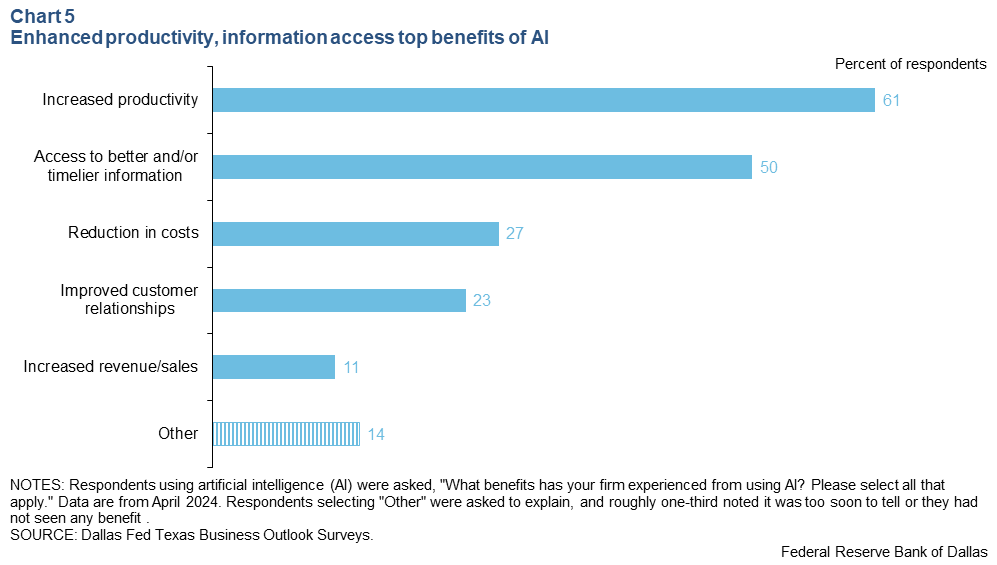
Texas firms using AI report little impact on employment
Learning how businesses use artificial intelligence (AI) helps policymakers understand changing economic conditions, particularly involving employment and productivity.
The Dallas Fed’s Texas Business Outlook Surveys (TBOS) asked respondents a series of special questions earlier this quarter focused on AI, technology that enables computers and machines to simulate human intelligence and problem-solving capabilities. TBOS special questions provide the Dallas Fed timely and valuable insights on a variety of policy-relevant topics from a panel of more than 400 businesses.
Of the 363 responding Texas business executives, nearly 40 percent use AI at their firms, and 16 percent are planning to use it in the next 12 months. Among firms using AI, about half say they use generative AI, which autonomously generates new content, unlike traditional AI, which relies on explicit programming to execute tasks.
AI use particularly notable at large businesses
AI use is still in its early stages at most businesses. A special question in 2018 asked about a broad range of technology use, including AI. Just 5 percent of firms reported adopting AI, with another 8 percent in the process of introducing it.
Today, the extent of AI use varies across firm size and industry. Large firms with more than 500 employees are more likely to use AI than small firms (Chart 1).

Implementation is often a greater barrier to AI use among small firms, with one respondent saying, “We are a small business and would like to use AI to automate processes but don't have the labor, time or expertise right now to do it.”
Said another, “We do believe AI has merit, but how do we implement, establish guardrails to keep us out of the ditch and build confidence in the concept? Those are big questions and tall challenges for smaller firms that are not easily answered.”
White-collar industries such as professional and business services and financial activities report the greatest AI use, while leisure and hospitality and manufacturing report the lowest.
Survey data were also collected on plans for future AI use, and health care appears poised for greater AI implementation. Half of health care firms say they plan to start using AI in the next 12 months, notably higher than the 10–15 percent share across other large industries.
Business analytics and customer service are top AI uses among large Texas businesses (Chart 2). At small firms, AI is mostly devoted to marketing, followed by process automation, particularly for manufacturers. Retailers cite advertising and customer service as top uses.

Impact on employment minimal so far
Most companies using AI report it has not affected their need for workers (Chart 3). A financial services firm noted, “AI is helpful in offloading workload and increasing productivity, but we are not at the point where AI is going to replace workers.”

Ten percent of companies using AI say it reduced their need for employees; these firms were largely using AI for customer service and process automation. A manufacturer noted, “There is strong potential for AI to automate or eliminate many clerical jobs in our business that will save our team time and money.” Workforce reductions from AI use are notably more common among large firms than small ones.
Among the modest share of firms reporting an employment impact from AI, decreased employment is most common for low-skill positions (Chart 4). This finding highlights the need for these workers to adapt and acquire new skills more pertinent to a data-driven economy.

Job gains as a result of AI have largely been among high-skilled workers. This offers some empirical insight into the question of whether AI will substitute or complement high-skilled jobs, at least in the short run.
High-skilled positions are thought to be more vulnerable to AI disruption than prior automation technologies were. These workers, however, may also be better poised to reap AI benefits via complementary job opportunities, countering, at least to some extent, AI’s negative impact, according to a recent study by the International Monetary Fund.
In addition, AI may also generate totally new job positions, such as prompt engineering, the process of structuring an instruction so it can be interpreted and understood by a generative AI model. The AI impact is more mixed for mid-skill workers.
Survey findings suggest more AI-related workforce reductions are expected among firms planning to use AI than those that have already implemented it. This could reflect hope that AI will be more impactful than it actually is once it’s implemented. The disparity between expectations and implementation is most pronounced among small firms and manufacturers. One small transportation manufacturer reported, “AI is more challenging to implement than anticipated, and the impact is currently lower than expected.”
It could also be that the AI employment impact is ongoing and may take several years to play out. A third possibility is firms that are early adopters have different characteristics than firms that are planning to adopt, and those differences could account for the disparity.
Users see increased productivity, improved information
Increased productivity is the top benefit AI users cite (Chart 5). To the extent this impact is on workers, the finding is in line with research showing AI is particularly useful among novice and low-skilled workers, helping them along the experience curve.

Productivity gains from AI vary by industry and are most pronounced in professional and business services and health care. These improvements are slightly more common among large firms that benefit from economies of scale than small firms.
While productivity gains are widespread, the extent of realized advances is not measured and likely difficult to quantify. Estimates of aggregate productivity improvement from AI vary widely from modest to much more significant.
Access to better or more timely information is another top realized benefit of AI use, particularly among manufacturers. Other benefits, such as customer relationships, cost reductions and increased revenue, are expected more by future AI users than actually experienced by existing ones.
Misinformation, privacy cited as top concerns
When firms were asked about their concerns, misinformation topped the list, particularly for generative AI users. Privacy ranked second, with a large consulting firm pointing to a lack of established procedures regarding the security of proprietary information. Social surveillance or manipulation was another top concern, particularly for traditional AI use.
Additionally, while generative AI is helpful in writing job postings and recruitment materials, one contact said applicants, in turn, can use generative AI to create “expert cover letters, profiles and resumes based on key words rather than true experience and skill sets,” making “it challenging to discern candidates’ true skill level and fitness.”
Broader impact still largely unknown
Because AI adoption remains in relative infancy, it is too soon to know the full impact on businesses, workers and the economy.
While TBOS provides important insights, other AI surveys differ on implications and the extent of usage. For example, the Census Bureau’s Business Trends and Outlook Survey AI supplement estimates 5 percent of U.S. businesses “use AI in producing goods or services.” Meanwhile, a McKinsey & Co. survey suggests 72 percent of responding organizations have “adopted AI in at least one business function.” Variation across survey results is likely due to many factors, including question wording and the survey sample.
Previous episodes of technological change suggest fears of widespread, persistent job loss from AI are unfounded. In addition, the speed of AI adoption may vary.
ChatGPT, for example, became the fastest spreading tech platform by individual users in history after its release in late 2022. But meaningful adoption of AI by companies could be slower than anticipated. At the same time, some contacts noted high inflation and reduced access to capital may accelerate the adoption of AI, as companies aim to cut costs and boost profitability.
There is significant uncertainty about what segments of the workforce will be most impacted and what effect AI will ultimately have on income inequality. If AI meaningfully complements high-skilled workers, it may lead to a disproportionate increase in their incomes, exacerbating inequality. AI may also widen the gap between capital and labor income as those who own stock in the companies developing AI are poised to reap large gains.
The Dallas Fed intends to pose TBOS special questions on AI regularly in coming years to track this important development.
About the authors





